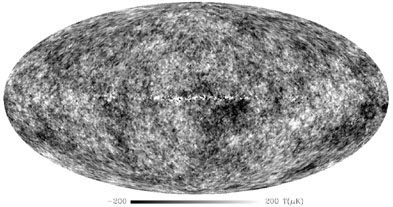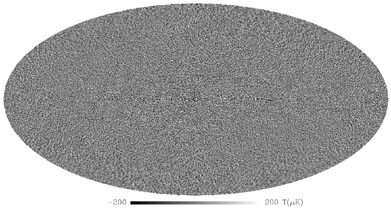


7.7. What are the oldest fossils we have from the early universe?
It is sometimes said that the CMB gives us a glimpse of the Universe when it was ~ 300, 000 years old. This is true but it also gives us a glimpse of the Universe when it was less than a trillionth of a second old. The acoustic peaks in the power spectrum (the spots of size less than about 1 degree) come from sound waves in the photon-baryon plasma at ~ 300, 000 years after the big bang but there is much structure in the CMB on angular scales greater than 1 degree. When we look at this structure we are looking at the Universe when it was less than a trillionth of a second old. The large scale structure on angular scales greater than ~ 1 degree is the oldest fossil we have and dates back to the time of inflation. In the standard big bang model, structure on these acausal scales can only be explained with initial conditions.
The large scale features in the CMB, i.e., all the features in the top map of Fig. 13 but none of the features in the lower map, are the largest and most distant objects every seen. And yet they are probably also the smallest for they are quantum fluctuations zoomed in on by the microscope called inflation and hung up in the sky. So this map belongs in two different sections of the Guinness book of world records.
 |
 |
Figure 13. Two basic ingredients: old
quantum fluctuations (top) and new sound (bottom).
These two maps were constructed from
Fig. 12.
The top map is a smoothed version of
Fig. 12
and shows only power at angular scales greater than ~ 1 deg
( |
The small scale structure on angular scales less than ~ 1 degree (lower map) results from oscillations in the photon-baryon fluid between the redshift of equality and recombination. Figure 11 describes these oscillations in more detail.